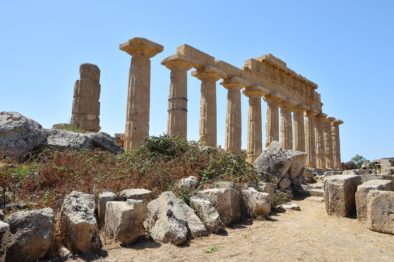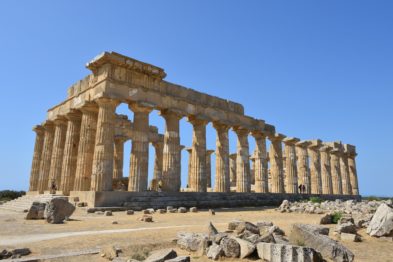What to do in Selinunte: the new Pompei is in Sicily
«Today we recommend a destination rich with history and nature, where culture and relaxation are intertwined in an indissoluble way. Here’s what to do in Selinunte, a small town in Sicily.»
Selinunte, an ancient Greek city located on the southwest coast of Sicily, is now recognized as the largest archaeological park in Europe. It is part of the territory of the municipality of Castelvetrano, in the province of Trapani. Selinunte, called “Selinùs” by the Greeks, derives its name from σέλινον, the celery that still grows wild, which has become a symbol of the coinage of the city. The latter was short-lived, around 240 years, and it reached a population of 100,000. The state in which Selinunte is presented today is not only due to its destruction by the Carthaginians, but also to earthquakes, centuries of neglect and serious looting. Because of the presence of ancient remains, the city is called a “new Pompeii”, this time located in Sicily. But, besides this, Selinunte also offers an unmatchable sea, with a suggestive marine protected area, untainted beaches, which are all ingredients that can give days of complete relaxation to those who choose to visit it. Let’s take a look at what to do in Selinunte.
In our guide on what to do in Selinunte you must start from the archaeological park, 250 hectares wide, an exhilarating example of Greek civilization in Sicily. Established in 1993 to protect the vast extent of the exhibits, it is divided into four distinct areas:
- The eastern hill was a suburb of the town. The scene is completely dominated by the remains of the three temples E, F, and G. The temple E, built in Doric style in the 5th century BC, is the building that best presents itself in the Archaeological Park: dedicated to Hera (Juno), it was rebuilt in 1958 with the 38 columns hoisted again. Temple F is the smallest and oldest of the three, dating back to the 6th century BC. The temple G, dedicated to Apollo, is the largest of Selinunte and it is a work of rare majesty for the Greek world: its construction was started in the 6th century BC but it was probably never completed. Today it looks like a pile of ruins;
- The acropolis of Selinunte, located a few meters from the sea, was surrounded by robust walls which are still partly visible. The complex of the north gate, made up of towers, underground tunnels and catapults, is one of the most magnificent military structures of ancient Sicily. In the southern area of the acropolis there were small buildings in which the sign of Tanit was found, symbol of the Phoenician divinity protector of the city and commerce. On the east side the temples O and A were built, of which only a few blocks remain. Further north are the temples C, B, and D. Temple C, dedicated to Apollo, is the largest building of the acropolis and is placed in the highest position, a very scenic view on the coast of Selinunte. Collapsed because of a strong earthquake, it was partly lifted again during the1920s. From this temple 3 metopes were brought to the Archaeological Museum of Palermo, high relief sculptures once placed in the upper part of the temple. The temple D, of considerable size, was built in honor of Aphrodite, although some scholars do not exclude that it was Athena the goddess who was worshipped in this place. Placed further north than the other temples of the acropolis, it had 38 columns in total;
- The Gaggera hill, which is flanked by the Modione river, was the sacred part of the city: here, sacrifices were served to the Gods and funeral processions stopped there before reaching the necropolis. It is the shrine of Demetra Malaphoros (the goddess of the pomegranate) the building that represented the sacredness of the whole area: built during the first half of the 6th century, it is a large structure where small jars containing the ashes of sacrifices have been found as well as figurines depicting a female figure carrying a pomegranate. Inside there is still the great altar of sacrifices;
- The hill of Manuzza, which was once the main inhabited area of the city, is today of no particular interest.
In answering the question what to do in Selinunte, and having concluded the strictly archaeological part, it is essential to immerse yourself in the pristine nature, made of wide beaches, clear sea and lush green. These are the peculiarities of this coastal area. Not far from the coast there is the integral Nature Reserve of the Belice river mouth and the surrounding dunes. The Belice River is one of the largest in the entire region and flows directly into the Mediterranean Sea. The reserve is characterized by the presence of wide sandy dunes and a flourishing Mediterranean forest.
Among the beaches that can be chosen when deciding what to do in Selinunte, there are:
- Marinella di seminante, a beach that stretches for over 5 km, is located in the inner part of the gulf, not far from the Acropolis of Selinunte and the mouth of the Belice River. Its beach is characterized by the presence of red sand as well as areas equipped with beaches and restaurants.
- Pineta: it’s located in the internal part of the Bellice River Nature Reserve. It’s very wide, you can easily reach it on foot, the sand is golden, the sea is crystal clear.
- Scalo di Bruca al Porto: in the central part of Marinella di Selinunte we find the third beach, one of the busiest on the coast due to its easy accessibility. The nearby marina divides the lido into 2: on the right side you can practice water sports as well as wind sports such as sailing, kitesurfing, surfing, etcetera. The right side, usually, is less crowded and is an ideal area for those who want to spend their holidays in a relaxing environment. On the left side of the beach, on the other hand, youcan practice team sports, such as beach soccer and beach volleyball.
- Triscina: the last beach stretches for 6 km, with an uncontaminated environment and subjected to continuous modeling by the wind.

–Talking about what to do in Salinunte does not exempt from suggesting to have lunch or dinner in one of the many restaurants / trattorias that offer the best of Sicilian cuisine. In the summer, in seaside resorts, the custom is to eat freshly caught fish and cooked in a short time to bring to the table of fresh appetizers that taste of the sea but also tasty first and second courses. A special feature of the area is the toasted Castelvetrano black bread with sesame seeds. Another genuine product, which is the flagship of local agricultural production, is extra virgin olive oil. To this are added the symbols of Sicilian pastry. Seeing is believing.
Chiara Rocca
what to do in selinunte





